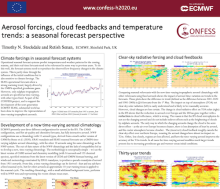Aerosol forcings, cloud feedbacks and temperature trends: a seasonal forecast perspective
Timothy
Stockdale
ECMWF
Poster
Operational seasonal forecast systems predict temperatures and weather patterns for the coming seasons, and their real-time forecasts need to be referenced in some way to previous years. To do this well, the forecast systems need to reproduce the observed low-frequency changes in the climate system. This is partly done through the influence of the initial conditions, but is also sensitive to climate forcings, even in the first months of the forecast. As part of the CONFESS project, and to support the development of the next-generation ECMWF SEAS6, substantial work has been done to improve the representation of time-varying tropospheric aerosols.
Experiments with new time-varying aerosol climatologies, derived from specified-emissions runs of the ECMWF CAMS chemistry-aerosol model, demonstrate the role of various aerosol species and their optical properties on the radiative forcings. The impact of improved aerosol treatment on 2-metre temperature trends in seasonal forecasts is less helpful than hoped for in some regions such as northern Europe, apparently due to a dominant semi-direct cloud feedback.
Detailed comparison of trends in seasonal forecast systems with observations shows areas of both agreement and disagreement, and due to the more constrained nature of the problem may provide useful insight as to what the models do and do not capture.
Experiments with new time-varying aerosol climatologies, derived from specified-emissions runs of the ECMWF CAMS chemistry-aerosol model, demonstrate the role of various aerosol species and their optical properties on the radiative forcings. The impact of improved aerosol treatment on 2-metre temperature trends in seasonal forecasts is less helpful than hoped for in some regions such as northern Europe, apparently due to a dominant semi-direct cloud feedback.
Detailed comparison of trends in seasonal forecast systems with observations shows areas of both agreement and disagreement, and due to the more constrained nature of the problem may provide useful insight as to what the models do and do not capture.

Poster file
stockdale-tim-confronting-poster.pdf
(2.23 MB)
